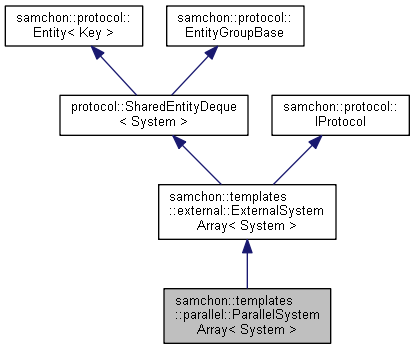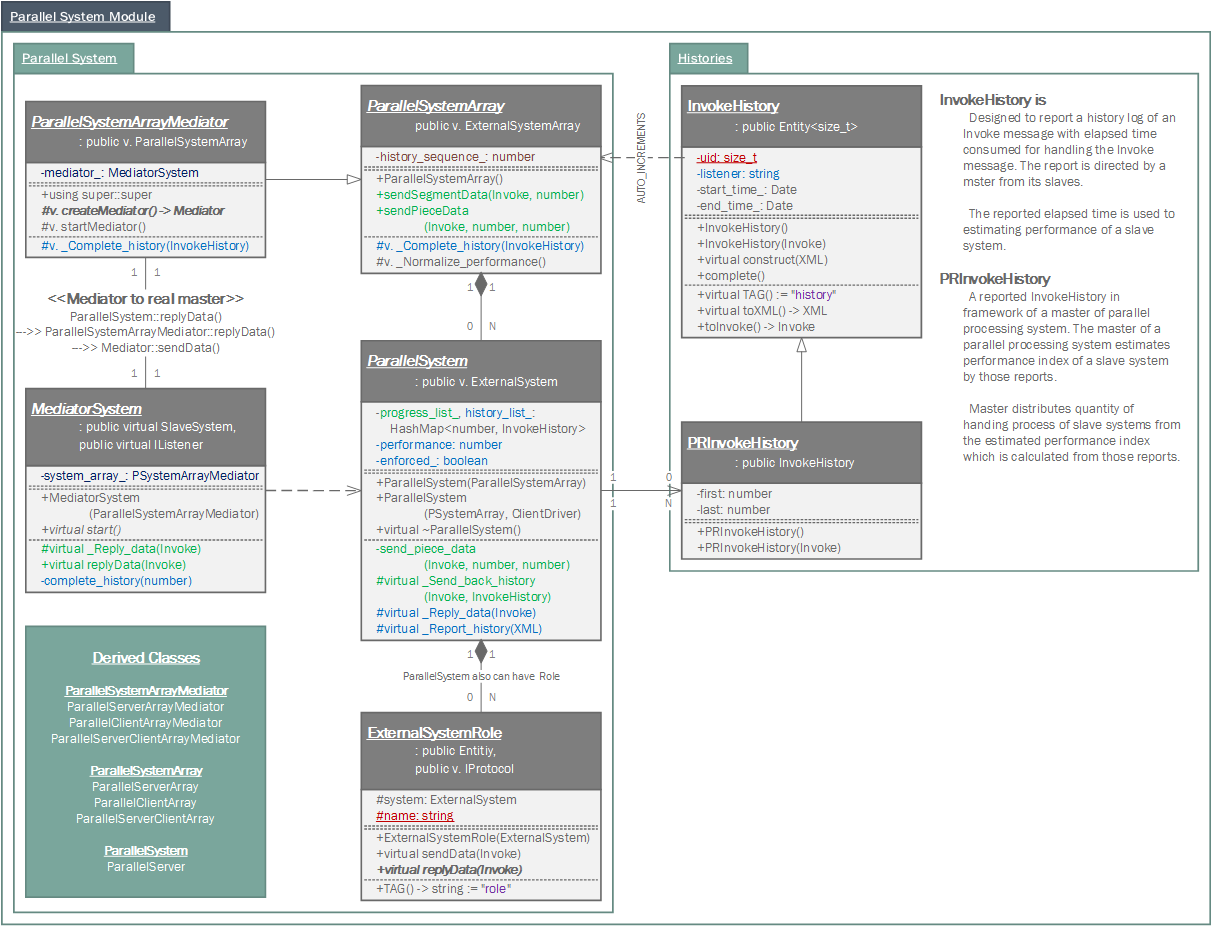|
Samchon Framework for CPP
1.0.0
|
|
Samchon Framework for CPP
1.0.0
|
#include <ParallelSystemArray.hpp>

Public Member Functions | |
| ParallelSystemArray () | |
| Default Constructor. More... | |
| auto | sendSegmentData (std::shared_ptr< protocol::Invoke > invoke, size_t size) -> size_t |
| virtual auto | sendPieceData (std::shared_ptr< protocol::Invoke > invoke, size_t first, size_t last) -> size_t |
 Public Member Functions inherited from samchon::templates::external::ExternalSystemArray< System > Public Member Functions inherited from samchon::templates::external::ExternalSystemArray< System > | |
| ExternalSystemArray () | |
| virtual | ~ExternalSystemArray ()=default |
| auto | hasRole (const std::string &key) const -> bool |
| auto | getRole (const std::string &key) const -> std::shared_ptr< ExternalSystemRole > |
| virtual void | sendData (std::shared_ptr< protocol::Invoke > invoke) |
| virtual void | replyData (std::shared_ptr< protocol::Invoke > invoke)=0 |
| virtual auto | CHILD_TAG () const -> std::string override |
| A tag name of children. More... | |
 Public Member Functions inherited from samchon::protocol::EntityGroup< Container, T, Key > Public Member Functions inherited from samchon::protocol::EntityGroup< Container, T, Key > | |
| virtual void | construct (std::shared_ptr< library::XML > xml) |
| Construct data of the Entity from an XML object. More... | |
| auto | find (const typename child_type::key_type &key) -> typename container_type::iterator |
| Get iterator to element. More... | |
| auto | find (const typename child_type::key_type &key) const -> typename container_type::const_iterator |
| Get const iterator to element. More... | |
| auto | has (const typename child_type::key_type &key) const -> bool |
| Indicates whether a container has an object having the specified identifier. More... | |
| auto | count (const typename child_type::key_type &key) const -> size_t |
| Count elements with a specific key. More... | |
| auto | get (const typename child_type::key_type &key) -> typename container_type::value_type & |
| Access the element by specified identifier(key). More... | |
| auto | get (const typename child_type::key_type &key) const -> const typename container_type::value_type & |
| Access the const element by specified identifier(key). More... | |
| virtual auto | toXML () const -> std::shared_ptr< library::XML > |
| Get an XML object represents the EntityGroup. More... | |
 Public Member Functions inherited from samchon::protocol::Entity< Key > Public Member Functions inherited from samchon::protocol::Entity< Key > | |
| virtual auto | key () const -> Key |
| Get a key that can identify the Entity uniquely. More... | |
 Public Member Functions inherited from samchon::protocol::IProtocol Public Member Functions inherited from samchon::protocol::IProtocol | |
| virtual void | replyData (std::shared_ptr< Invoke >)=0 |
| virtual void | sendData (std::shared_ptr< Invoke >)=0 |
Additional Inherited Members | |
 Protected Member Functions inherited from samchon::protocol::EntityGroup< Container, T, Key > Protected Member Functions inherited from samchon::protocol::EntityGroup< Container, T, Key > | |
| virtual auto | createChild (std::shared_ptr< library::XML >) -> child_type *=0 |
| Factory method of a child Entity. More... | |
Master of Parallel Processing System.
The ParallelSystemArray is an abstract class containing and managing remote parallel slave system drivers, ParallelSystem objects. Within framework of network, ParallelSystemArray represents your system, a Master of Parallel Processing System that requesting parallel process to slave systems and the children ParallelSystem objects represent the remote slave systems, who is being requested the parallel processes.
You can specify this ParallelSystemArray class to be a server accepting parallel clients or a client connecting to parallel servers. Even both of them is possible. Extends one of them below and overrides abstract factory method(s) creating the child ParallelSystem object.
When you need the parallel process, then call one of them: sendSegmentData or sendPieceData. When the parallel process has completed, ParallelSystemArray estimates each ParallelSystem's performance index basis on their execution time. Those performance indices will be reflected to the next parallel process, how much pieces to allocate to each ParallelSystem.

This class ParallelSystemArray is derived from the ExternalSystemArray class. Thus, you can take advantage of the Proxy Pattern in the ParallelSystemArray class. If a process to request is not the parallel process (to be distrubted to all slaves), but the exclusive process handled in a system, then it may better to utilizing the Proxy Pattern:
The ExternalSystemArray class can use Proxy Pattern. In framework within user, which external system is connected with this system, it's not important. Only interested in user's perspective is which can be done.
By using the logical proxy, user dont't need to know which role is belonged to which system. Just access to a role directly from ExternalSystemArray.getRole. Sends and receives Invoke message via the role.
Definition at line 77 of file ParallelSystemArray.hpp.
|
inline |
Default Constructor.
Definition at line 91 of file ParallelSystemArray.hpp.
|
inline |
Send an Invoke message with segment size.
Sends an Invoke message requesting a parallel process with its segment size. The Invoke message will be delivered to children ParallelSystem objects with the piece size, which is divided from the segment size, basis on their performance indices.
| Name | Performance index | Number of pieces to be allocated | Formula |
|---|---|---|---|
| Snail | 1 | 10 | 100 / 10 * 1 |
| Cheetah | 4 | 40 | 100 / 10 * 4 |
| Rabbit | 3 | 30 | 100 / 10 * 3 |
| Turtle | 2 | 20 | 100 / 10 * 2 |
When the parallel process has completed, then this ParallelSystemArraY will estimate performance indices of ParallelSystem objects basis on their execution time.
| invoke | An Invoke message requesting parallel process. |
| size | Number of pieces to segment. |
Definition at line 131 of file ParallelSystemArray.hpp.
|
inlinevirtual |
Send an Invoke message with range of pieces.
Sends an Invoke message requesting a parallel process with its range of pieces [first, last). The Invoke will be delivered to children ParallelSystem objects with the newly computed range of sub-pieces, which is divided from the range of pieces (first to last), basis on their performance indices.
| Name | Performance index | Range of sub-pieces to be allocated | Formula |
|---|---|---|---|
| Snail | 1 | ( 0, 5] | (50 - 0) / 10 * 1 |
| Cheetah | 4 | ( 5, 25] | (50 - 0) / 10 * 4 + 5 |
| Rabbit | 3 | (25, 40] | (50 - 0) / 10 * 3 + 25 |
| Turtle | 2 | (40, 50] | (50 - 0) / 10 * 2 + 40 |
When the parallel process has completed, then this ParallelSystemArraY will estimate performance indices of ParallelSystem objects basis on their execution time.
| invoke | An Invoke message requesting parallel process. |
| first | Initial piece's index in a section. |
| last | Final piece's index in a section. The range used is [first, last), which contains all the pieces' indices between first and last, including the piece pointed by index first, but not the piece pointed by the index last. |
Definition at line 166 of file ParallelSystemArray.hpp.
Referenced by samchon::templates::parallel::ParallelSystemArray< SlaveDriver >::sendSegmentData().
